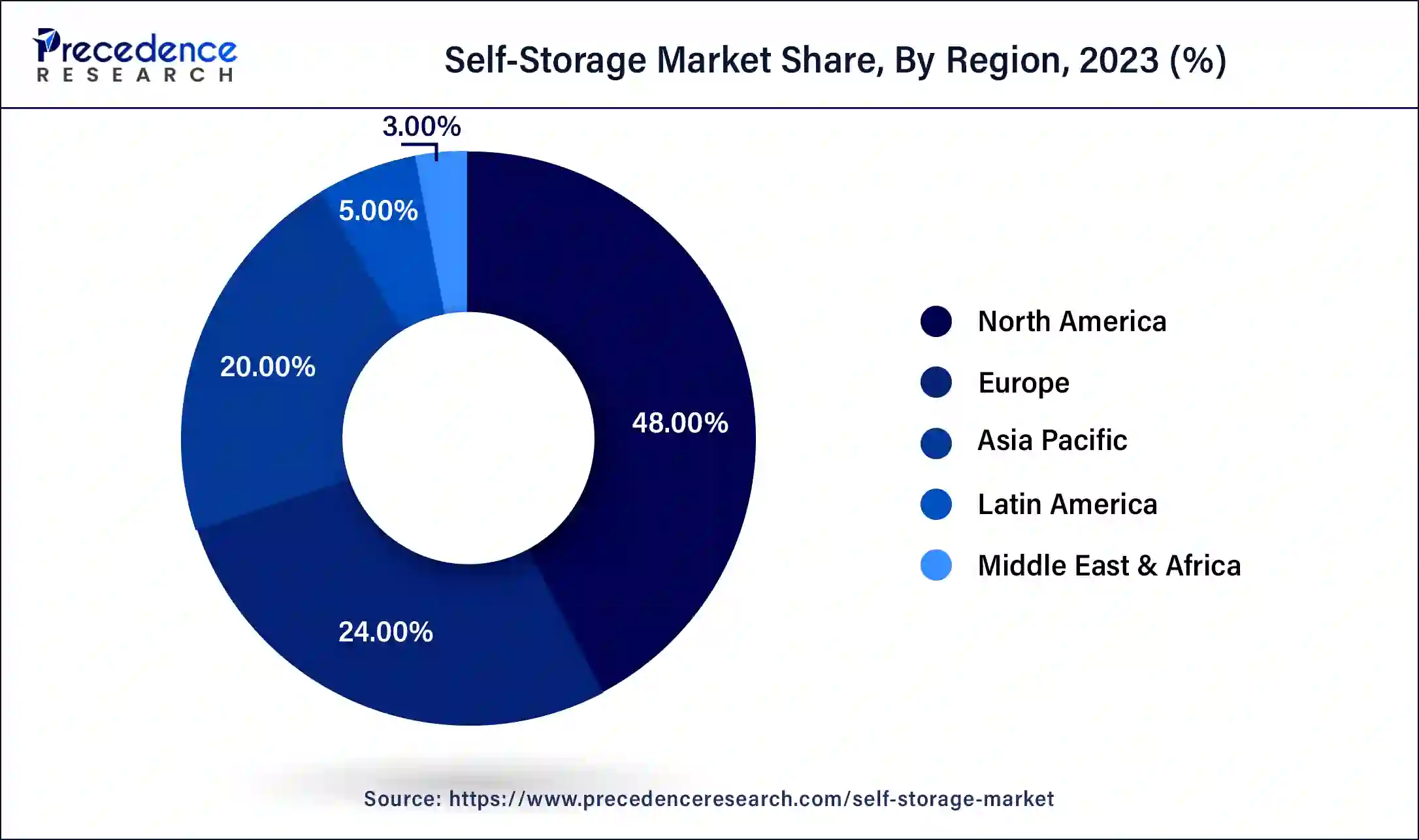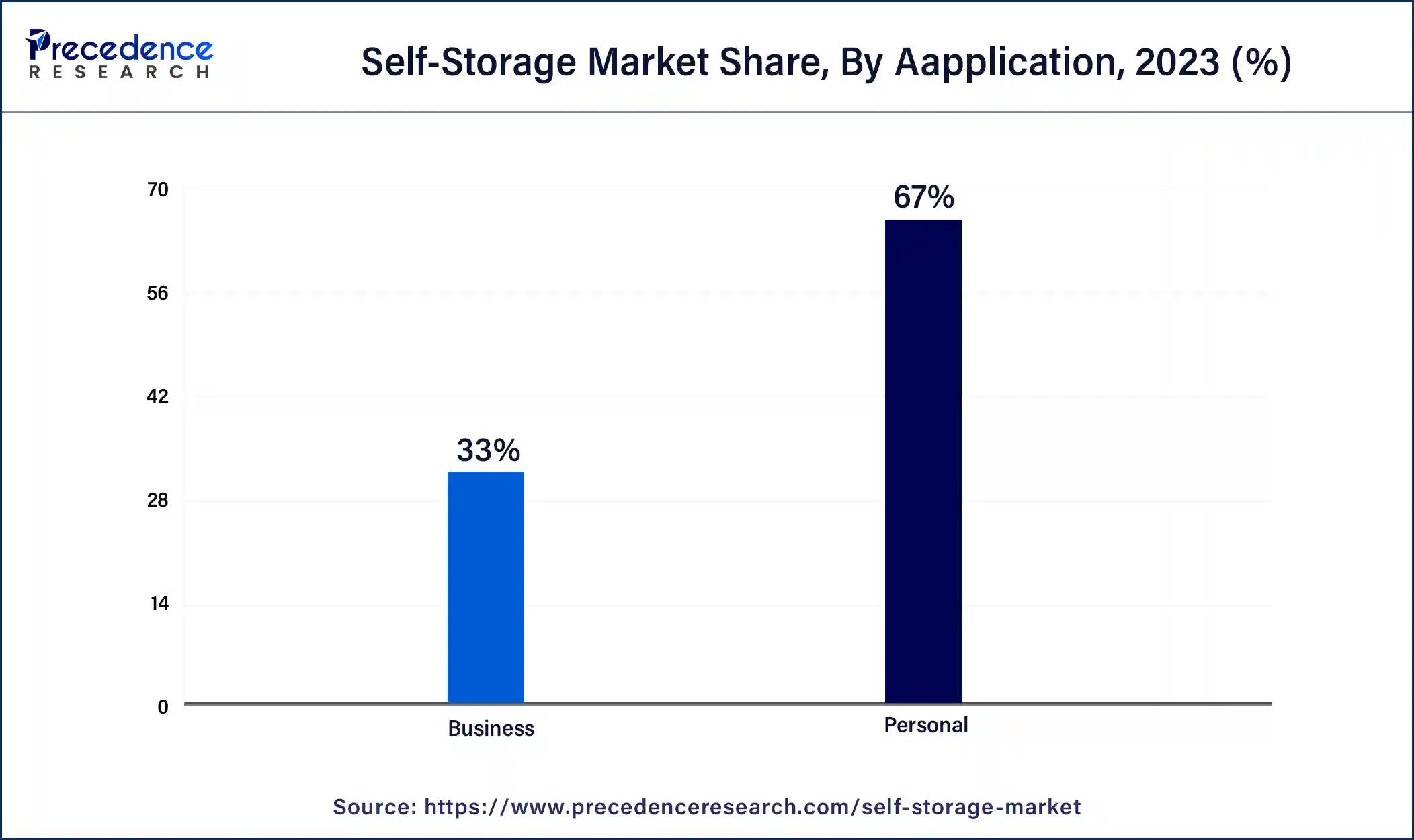March 2025
The global self-storage market size surpassed USD 57.03 billion in 2023 and is estimated to increase from USD 60.41 billion in 2024 to approximately USD 107.36 billion by 2034. It is projected to grow at a CAGR of 5.91% from 2024 to 2034.
The global self-storage market size is estimated to be worth around USD 107.36 billion by 2034 from USD 60.41 billion in 2024, at a CAGR of 5.91% from 2024 to 2034. The North America self-storage market size reached USD 27.37 billion in 2023. Growth factor of the self-storage market include urbanization, growing incomes, new and diverse customers’ lifestyles, shift in economic performance, and technological innovation create expanded business prospects for supply.

The U.S. self-storage market size was exhibited at USD 20.53 billion in 2023 and is projected to be worth around USD 39.31 billion by 2034, poised to grow at a CAGR of 6.08% from 2024 to 2034.

North America led the global self-storage market in 2023. The United States and Canada have a well-developed network of self-storage facilities ranging from personal to business storage. Noticeable drivers driving the market demand for self-storage include the rising need for storage, mobility, and congestion. They use the latest technologies, including online bookings and electronic gate access. Moreover, the availability of variants is also increasing in the market, including climate control for the units.

Asia Pacific is anticipated to grow notably in the self-storage market during the forecast period due to factors such as a fast-growing urbanization rate, growing disposable income, and a growing middle-class population. Currently, this growth is being driven by countries such as China, Japan, and India. This is because the demand for storage solutions is higher in urban areas due to factors such as the high-density population and the rate at which people are adapting to new lifestyles. The market is shifting from traditional storage facilities to some centralized storage with security enhancement and technological features such as climate control and digital access.
Hong Kong is one of the most densely populated territories in the world. The limited land is quickly being occupied by its residents, leading to a shortage of living and storage space. As a result, many individuals opt to rent a self-storage unit to store items such as infrequently used belongings, home appliances, furniture, as well as company documents and merchandise in a conveniently accessible storage facility.
Self-storage or self-service storage popularly known as ‘device storage’ is an industry that provides renting of storage space or rooms lockers or containers and open area storage units to customers on a short-term basis mostly every month. Self-storage renters include businesses and individuals.
The self-storage market is of growing aspects rapidly as it provides confidence to individual as well as commercial clients about their equipment or personal belongings storage. A self-storage provider will have several choices for you from one-room storage, and warehouse storage, to box storage. The factors include factors like urbanization, economic recovery, and increased disposable income.
How is AI Changing the Self-storage Market?
The most relevant and practical use of AI in the self-storage market is indeed in the use of chatbots. AI-enabled chatbots can deal with customers, respond to customer queries, and perform other regular operations. They are launched with customer support available for 24/7 booking & reservation. Some of how AI smart security cameras and related access control systems are still developing might enhance self-storage security and the customer experience. Such systems can incorporate AI to alert security officials of any suspicious activities as they occur, hence minimizing cases of theft and unauthorized access. Another possible use could be using AI to connect to the access control systems and have the capabilities to recognize either the face or the license plate and open a certain access control point.
| Report Coverage | Details |
| Market Size by 2034 | USD 107.36 Billion |
| Market Size in 2023 | USD 57.03 Billion |
| Market Size in 2024 | USD 60.41 Billion |
| Market Growth Rate from 2024 to 2034 | CAGR of 5.91% |
| Largest Market | North America |
| Base Year | 2023 |
| Forecast Period | 2024 to 2034 |
| Segments Covered | Unit Size, Applicatio, and Regions |
| Regions Covered | North America, Europe, Asia-Pacific, Latin America and Middle East & Africa |
Increasing urbanization
Higher population density in urban areas largely results in individuals living in small residences and, hence, the need the self-storage market. With the growth of cities and population, density space is more of a scarcity. People live in crowded cities where there are limited accommodation spaces and or working spaces to accommodate all the items. This is why self-storage is a perfect solution when one is limited with space.
Self-storage markets are necessary for extra and unsuitable items that cannot be stored at home or in business places. This means that the requirements for storage space will only continue to grow as urbanization and population density, as well as lifestyles, expand. It is for this reason that those involved in the provision of self-storage businesses need to understand these drivers to be able to offer their services in response to customers’ needs.
Increase in the property and maintenance costs
The challenge that affects self-storage owners is an increase in property and maintenance costs that hinder the self-storage market. There is a direct relationship between the demand for storage and the price that is paid by self-storage firms for properties to use as storage space. Further, running these facilities may also prove expensive because these infrastructures may need frequent repairs and security, among other costs.
These costs of the self-storage market are gradually increasing, and for self-storage owners to keep running their businesses and keep making profits, they have to be very keen on managing costs. It can range from securing more attractive lease terms, using strategies and measures to minimize the cost of utilities, or else hiring maintenance services from outside. With tight management, the self-storage owners have a way of making sure that the facilities are financially sustainable.
E-commerce growth
Digital technology also offers an opportunity, especially for the self-storage business unit, because of the growth of e-commerce. With the progression of online retail, there is a growing need for spaces to store inventory for e-tailers and third-party logistics providers. Through the association of these businesses with self-storage facilities, the warehousing and distribution industry is offered, making it easier for the self-storage facility to penetrate deeper markets and achieve higher occupancy. This integration not only responds to the increase in storage demand from e-commerce but also increases the self-storage operators’ income opportunities and expands the company’s development prospects.
The medium segment accounted for the biggest share of the self-storage market in 2023 since they offered a reasonable quantity of space while not being too expensive to attract both small business and residential customers. This segment is expected to continue dominating the market and expand its growth rates in the outlook period based on the growing interest in multi-purpose storage that easily suits residential and commercial requirements.
The large segment is expected to witness significant growth in the self-storage market during the forecast period. The size options range from 10×20 to 10×30, which provides enough room for the storage of entire household goods, vehicles, small RV, or boats. The intended use of this segment is to address the demand for larger and more flexible space that is required for moving, car storage, and other house occupancy needs.
The personal segment accounted for the biggest share of the self-storage market in 2023. Personal storage relates to facilities that are confined and generally necessitate customers, who are availed of individual stalls or lockers for storage. This segment has the highest market share mostly because of its versatility for individual use, offering secure, highly accessible storage options for various applications.

The business segment is expected to grow significantly in the self-storage market during the forecast period. Whether it is for warehousing stocks, merchandised goods, storing raw materials, or simply running the business entirely from within a self-storage unit, it is just perfect for all business needs. The understanding of or ability to purchase a self-storage unit offers a more practical and relatively cheaper solution than opting to lease or buy an industrial or a commercial building such as a large warehouse. There is also an availability of storage warehouses for rent, so companies do not necessarily have to invest lots of cash, but they will nonetheless get adequate space for their merchandise.
Recent Developments
Segments Covered in the Report
By Unit Size
By Application
By Geography
For inquiries regarding discounts, bulk purchases, or customization requests, please contact us at sales@precedenceresearch.com
No cookie-cutter, only authentic analysis – take the 1st step to become a Precedence Research client
March 2025
November 2024
February 2025
October 2024